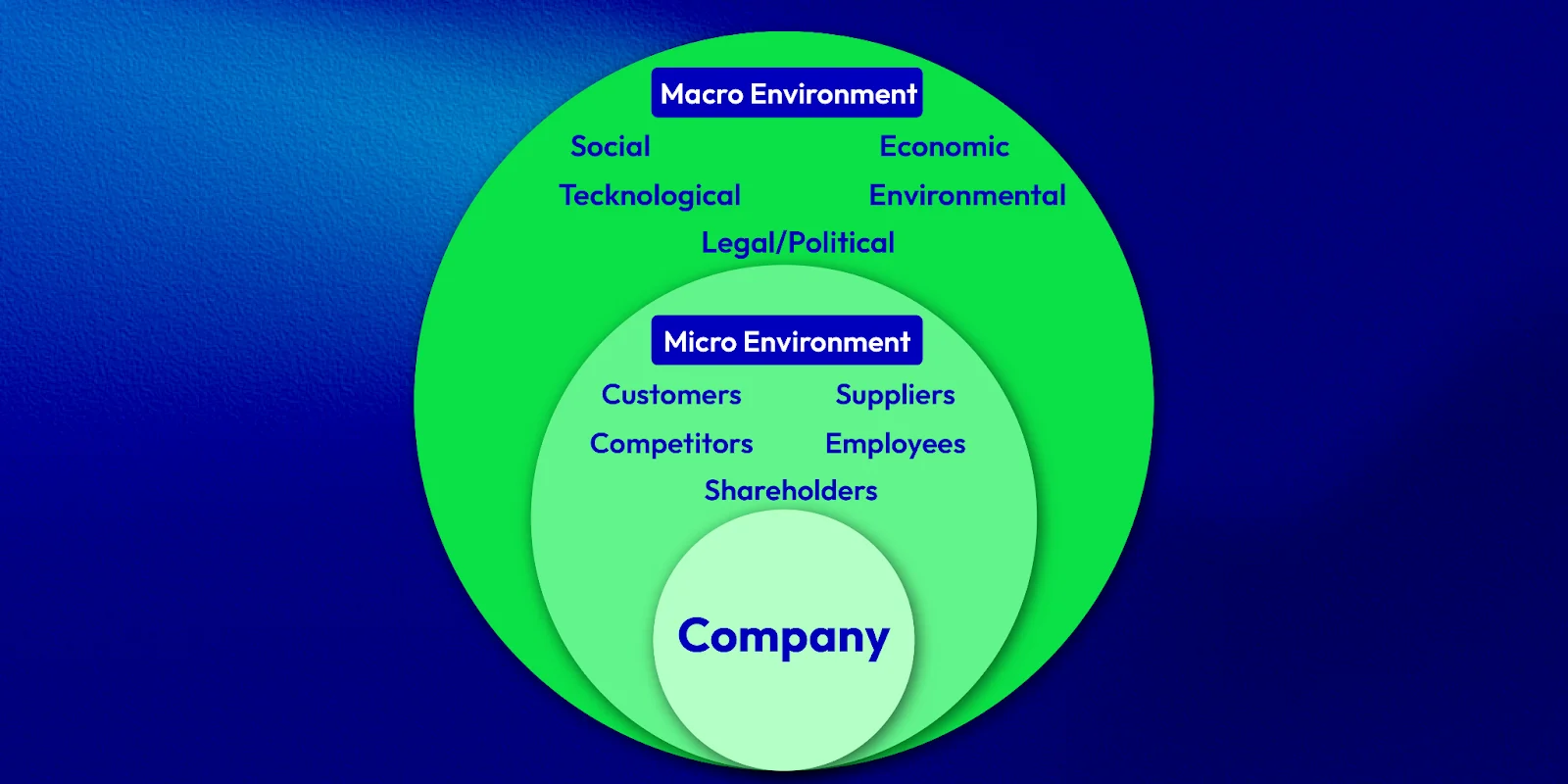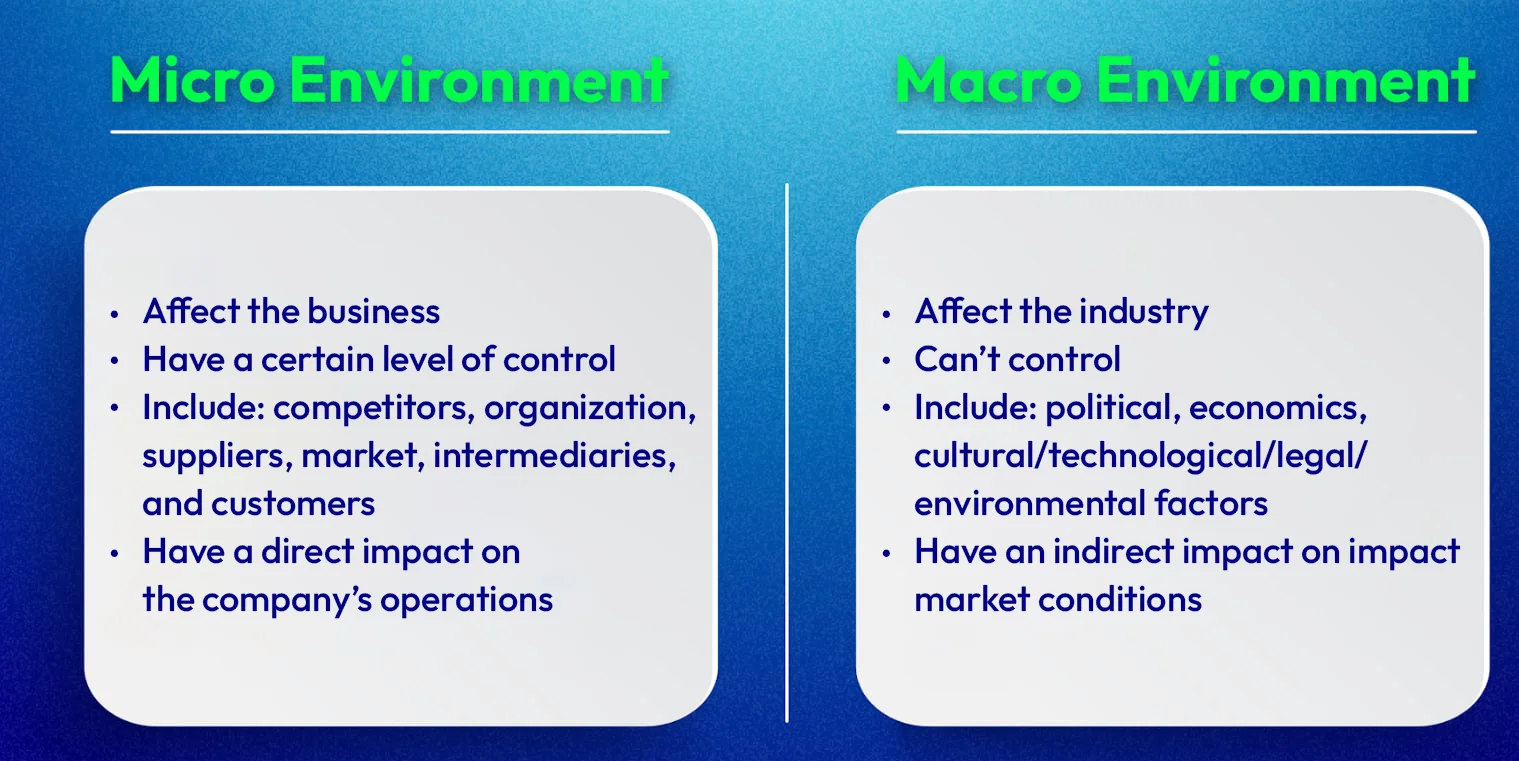Micro Environment vs. Macro Environment: Key Differences

Every business is affected by a myriad of factors. In other words, an organization as such can never exist and operate “in a vacuum”. It is a part of a larger entity known as the business environment. In broad terms, this environment can be divided into two categories. The first one is the micro-environment. This category influences the functionality of a particular business itself. The latter one is the macro-environment which affects the operation of all existing business entities out there.
The two categories may be different, but both are essential to understand in order to truly see your business in its full context. You have to be knowledgeable about the business environment in order to be able to track and comprehend how various factors affect your company.

What is the micro-environment?
The micro environment refers small, nearby factors that directly impact how a business operates and serves its customers. It focuses on close and manageable elements that influence day-to-day operations. Key parts of the micro environment include customers, suppliers, resellers, competitors.
Understanding and monitoring these elements helps businesses adapt, meet customer needs, and stay competitive.
What is the macro-environment?
The macro environment looks at the bigger picture - external forces that impact industries and businesses as a whole but are outside their direct control. Unlike the micro environment, which focuses on close-up factors like customers and suppliers, the macro environment deals with broader aspects, such as economy, society, technology, environment, politics and laws, and cultural forces.
By keeping an eye on these larger trends, businesses can identify potential opportunities or risks and adapt their strategies to keep up with our constantly changing world and stay competitive.
Micro-environment factors:
Customers
The kind of customer base that your company attracts, as well as the reasoning behind purchasing your product, are going to highly affect the way you create marketing campaigns. Besides, when it comes to choosing product photography ideas to display the advantages of items on offer, you have to look up to the marketing principles you’ve defined as the core.Your customers can be B2C, B2B, international, local, and so on. Adopting a cloud-based contact center can help streamline communication and support for these diverse customer segments.
Important factors related to customers are:
- Stability of demand
- Prospects of sale growth
- Relative profitability
- Intensity of competition
Suppliers
If a supplier of a particular product is the largest, or even the only one, they are certainly going to have a big influence on how successful your business is.
The suppliers are extremely important factors as:
- Key link in the value delivery process
- Insurance that your business has the necessary resources
- Essential determinants in terms of price increase or decrease
Resellers
If you decide to sell your product via a third party reseller, or middlemen such as wholesalers and retailers, then the success of your marketing is going to be highly dependent on them. If let’s say, a certain retail seller has a strong reputation, it will pass on to your product.
As a link between you and the customer, they are important in terms of these factors:
- Promotion
- Sale
- Distribution
- Marketing
- Financial mediation
Competitors
Logically, every business that sells the same or a similar kind of product as you do is your competition on the market. So, their sale and marketing tactics matter to you a lot. You need to answer various questions, such as how their product and its price affect yours and how you can make use of that in order to gain an edge over them.
The three factors that matter in this case are:
- Desire competition
- Product form competition
- Brand competition
The general public
Of course, every business organization has in its best interest to appease to the general public. Every step that you take needs to be viewed from their perspective as well. It is extremely important how your actions affect others because their opinion can be the one thing that either pushes you towards success or pulls you down from the pedestal.
So, the general public is very important in terms of:
- Public opinion
- Media
- Environmental pollution

Macro-environment factors
Economic factors
Basically, the very environment of the economy can have an effect on two essential aspects – your company’s levels of production and the decision-making process of your customers.
Some examples of economic factors affecting business:
- Interest rates
- Exchange rates
- Recession
- Inflation
- Taxes
- Demand / Supply
Demographic forces
Every chunk of the market is affected by universal demographic forces. These are age, education level, cultural characteristics, country and region, lifestyle, and so on.
The crucial variables include:
- How income variables influence business
- Age variables that affect business
- Geographic Region Variables
- Education Level as a Variable
Technological factors
These factors are related to skills and ability that are implemented into production, as well as all the materials and technology that a particular product requires to be made. They are essential and can have a big impact on how well your business is running. It boils down to even the most basic factors, such as what kind of maintenance trolleys you use in order to preserve your tools and equipment for as long as you possibly can.
Some of the most common technological factors are:
- Automation
- Internet connectivity
- 3D technology
- Speed/power of computer calculation
- Engine performance and efficiency
- Security in terms of cryptography
- Wireless charging

Site Audit Services
Mageplaza offers FREE site health check (15hrs) to help you identify any website flaws & weaknesses and fix them before they start costing you a fortune.
Explore MoreNatural and physical forces
Every business must also take into account the very planet and its resources. There are those that can be renewed, such as forests and agricultural products, and those that cannot, such as coal, minerals, oil, and the like. Both are strongly related to production. So, natural and physical forces can be:
- Climate change
- Pollution
- Weather
- Availability of both non-renewable and renewable resources
- Laws that regulate the environment
- Survival of particular biological species
Political and legal forces
The market develops according to the political and legal environment in various areas. This means that every business needs to be up to date with such forces worldwide to be able to make the right decisions.
This generally includes legal factors such as:
- Copyright law
- Employment law
- Fraud law
- Discrimination law
- Health and Safety law
- Import/Export law

You may care:
Social factors and cultural forces
Finally, it is crucial to understand that the product that you bring to the market can have a strong impact on society. For example, your production needs to eliminate every practice that is hazardous to society, and show that it is socially responsible. There is a wide variety of social and cultural factors, some of them being:
- Purchasing habits
- Level of education
- Religion and beliefs
- Consciousness about health issues
- Social classes
- Structure and size of a family
- Growth rate of the population
- Emigration and immigration rates
- Life expectancy rates and age distribution
- Different lifestyles
Key Differences Between Micro Environment and Macro Environment

| Aspect | Micro Environment | Macro Environment |
|---|---|---|
| Elements | COSMIC: Competitors, Organisation (the company itself), Suppliers, Market, Intermediaries, Customers. | PESTLE: Political, Economic, Socio-cultural, Technological, Legal, Environmental. |
| Control | Businesses have certain control through strategies affecting immediate stakeholders. | Businesses have nearly no control and must adapt through planning and forecasting. |
| Impact on Business | Directly affects daily operations, sales, and customer satisfaction. | Indirectly influences the overall business climate and market conditions over time. |
| Involvement | Involves entities closely connected to the company, with regular interactions. | Involves broader societal trends that the company doesn’t interact with directly but must consider. |
| Scope | Narrow scope, focused on the company’s immediate environment and direct relationships. | Broad scope, covering external national and global factors affecting the entire industry. |
| Predictability | Somewhat predictable due to close relationships, like anticipating new competitor products. | Less predictable, with economic changes or technological breakthroughs often being unexpected. |
| Adaptability and Response Time | Companies can adapt quickly to changes, like switching suppliers or adjusting prices. | Requires longer-term planning to respond to large-scale changes, like trade policies or new technologies. |
| Monitoring | It’s necessary to monitor regularly | Just need to monitor periodically |
| Example | Individual customers, local suppliers | Economic trends, government regulations |
SWOT analysis
The SWOT analysis (Strengths, Weaknesses, Opportunities, and Threats) is useful both for understanding the micro and the macro factors. The former two are internal and affect the very business, while the latter are external and not under the organization’s control.
In terms of strengths, you should ask yourself what you are good at, what value you bring, what kind of difference you make, and so on. On the other hand, when it comes to weaknesses, you need to evaluate your dependency on outside vendors, aspects that need to be improved, and so on.
Opportunities are related to favorable circumstances that the company needs to make use of in order to improve its position on the market. Threats are factors that cannot be controlled but need to be acknowledged. This includes political, economic, and customer trends, as well as debts and costs.
Two Sides of the micro and macro factors - Chance or Threat?
Both the micro and macro environments present challenges and opportunities for businesses. These can be seen as two sides of the same coin, where the same factor can be both a threat and an opportunity depending on how a business reacts.
Micro-environment
Opportunities
- Identifying unmet customer needs: Understanding customer preferences and desires in your immediate vicinity can lead to developing new products or services tailored to your local market.
- Building strong relationships with suppliers and distributors: Fostering close partnerships can result in better deals, more reliable supply chains, and increased efficiency.
- Outmaneuvering local competitors: Analyzing competitor strategies and weaknesses can help you differentiate yourself and attract customers.
- Leveraging local events and trends: Participating in local events or catering to specific cultural trends can generate positive publicity and attract new customers.
Threats
- Changes in customer preferences: Shifts in local tastes or purchasing behaviors can quickly hurt your sales.
- Disruptions in your supply chain: Local supplier issues or logistical problems can impact your production and availability of products.
- Intensified competition: Increased competition in your immediate area can put pressure on your prices and market share.
- Negative local publicity: Bad reviews, scandals, or negative local image can significantly damage your business reputation.
Macro-environment
Opportunities
- Taking advantage of economic growth: Expanding businesses during economic booms can lead to increased profits and market share.
- Adapting to technological advancements: Embracing new technologies can improve efficiency, reach new customers, and offer innovative products or services.
- Capitalizing on favorable government policies: Tax breaks, subsidies, or other government initiatives can create new business opportunities.
- Addressing social and environmental concerns: Aligning your business with sustainability practices or addressing social issues can attract customers and investors.
Threats
- Economic downturns: Recessionary periods can decrease consumer spending and hurt your business revenue.
- Disruptive technological shifts: Emerging technologies can render your current products or services obsolete.
- Uncertain political or legal landscape: Changes in government regulations or political instability can create risks and disrupt operations.
- Climate change and environmental factors: Extreme weather events, resource scarcity, or stricter environmental regulations can impact your business.
- Remember, these are just examples, and the specific opportunities and threats will vary depending on your industry, location, and size. It’s crucial for businesses to constantly monitor both the micro and macro environments and develop strategies to adapt and thrive in a changing landscape.
Related Post
- 4 P’s of marketing
- Pros and Cons of Net Neutrality
- A Situational Analysis of a Strategic Marketing Plan
- Analytical Tools for Business Analysis
- Internal & External Factors in the Business Environment
In Conclusion
Both micro and macro factors have a strong influence on how successful your business is. Every decision that you make needs to take these two environments into consideration. Your marketing strategies have to be based on them as well, if you truly want them to be lucrative, and retain a reputable position on the market.








![Top 20+ Must-have Shopify Apps for 2025 [Free & Paid] - Mageplaza](https://cdn2.mageplaza.com/media/blog/must-have-shopify-apps/top-must-have-shopify-apps.png)
![[2025 Updates] Top 10+ Upsell Apps for Shopify - Mageplaza](https://cdn2.mageplaza.com/media/blog/best-upsell-shopify-app/cover.png)